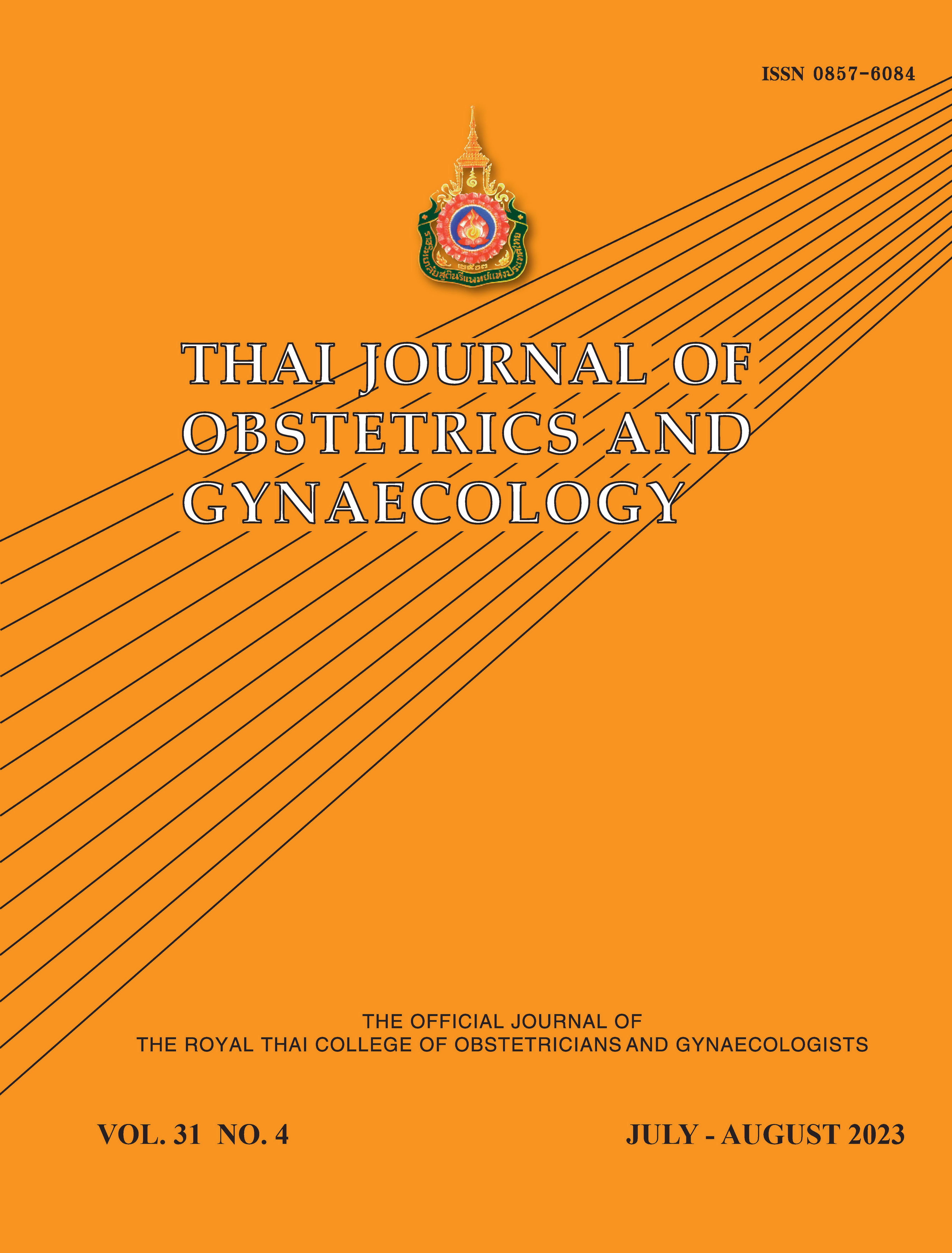Risk Factors Associated with Major Complications of Total Laparoscopic Hysterectomy
Main Article Content
Abstract
Objectives: To determine risk factors associated with major complications of Siriraj total laparoscopic hysterectomy (SiTLH) technique.
Materials and Methods: A case-control study was conducted in 275 women who underwent SiTLH at a university-based tertiary care hospital. Cases consisted of 55 women with major intraoperative complications. Controls were 220 women with the uneventful operation, randomly selected from those who underwent SiTLH during the same period as cases. Data were retrieved from medical records, including baseline and operative characteristics, diagnosis and indications, surgeon experience, and characteristics of the complications.
Results: Cases and controls were comparable in terms of baseline characteristics, including age, body mass index, diagnosis, and surgeon’s experience. Cases were significantly more likely to have previous abdominal surgery and have preoperative diagnosis of endometriosis. (41.8% vs 25%, p = 0.013 and 47.3% vs 29.5%, p = 0.012, respectively). In addition, cases were significantly more likely to have higher specimen weight, longer operative time, and estimated blood loss (p < 0.001). Among those with major complications, internal organ injuries occurred in 30 cases (54.5%) including injuries to bowel (21.8%), bladder (18.2%), and ureters (16.4%). Conversion to abdominal operation occurred in 32.7%. Multivariate analysis showed that, after adjusting for potential confounders, having had previous abdominal surgery and preoperative diagnosis of endometriosis independently increased risk of major complications (adjusted odds ratio (OR) 2.2, 95% confidence interval (CI) 1.2-4.29, p = 0.015 and adjusted OR 2.1, 95%CI 1.1-4.1, p = 0.019, respectively).
Conclusion: Having had previous abdominal surgery and preoperative diagnosis of endometriosis independently increased the risk of major complications of SiTLH procedure.
Article Details

This work is licensed under a Creative Commons Attribution-NonCommercial-NoDerivatives 4.0 International License.
References
Crosignani PG, Vercellini P, Biffignandi F, Costantini W, Cortesi I, Imparato E. Laparoscopy versus laparotomy in conservative surgical treatment for severe endometriosis. Fertil Steril 1996;66:706-11.
Johnson N, Barlow D, Lethaby A, Tavender E, Curr E, Garry R. Methods of hysterectomy: systematic review and meta-analysis of randomized controlled trials. Br Med J 2005;330:1478-85.
Srichaikul P, Chalermchockcharoenkit A, Yahata H, Sirimai K, Sutchritpongsa P. Low complication rate associated with total laparoscopic hysterectomies using the retroperitoneal approach: a series of 1,092 cases in Siriraj Hospital. SMJ 2018;70:191-7.
Magrina JF. Complications of laparoscopic surgery. Clin Obstet Gynecol 2002;45:469-80.
Fuentes MN, Rodriguez-Oliver A, Naveiro Rilo JC, Paredes AG, Aguilar Romero MT, Parra JF. Complications of laparoscopic gynecologic surgery. JSLS 2014;18:1-9.
Sokol AI, Chuang K, Milad MP. Risk factors for conversion to laparotomy during gynecologic laparoscopy. J Am Assoc Gynecol Laparosc 2003;10:469-73.
Kaya AC, Radosa MP, Zimmermann JSM, Stotz L, Findeklee S, Hamza A, et al. Intraoperative and postoperative complications of gynecological laparoscopic interventions: incidence and risk factors. Arch Gynecol Obstet 2021;304:1259-69.
Chi DS, Abu-Rustum NR, Sonoda Y, Awtrey C, Hummer A, Venkatraman ES, et al. Ten-year experience with laparoscopy on a gynecologic oncology service: Analysis of risk factors for complications and conversion to laparotomy. Am J Obstet Gynecol 2004;191:1138-45.
Jansen FW, Kapiteyn K, Trimbos-Kemper T, Hermans J, Trimbos JB. Complications of laparoscopy: a prospective multicentre observational study. Br J Obstet Gynaecol 1997;104:595-600.
Shah DK, Vitonis AF, Missmer SA. Association of body mass index and morbidity after abdominal, vaginal, and laparoscopic hysterectomy. Obstet Gynecol 2015;125:589-98.
Dindo D, Demartines N, Clavien PA. Classification of surgical complications: a new proposal with evaluation in a cohort of 6336 patients and results of a survey. Ann Surg 2004;240:205-13.
Audebert AJ, Gomel V. Role of microlaparoscopy in the diagnosis of peritoneal and visceral adhesions and in the prevention of bowel injury associated with blind trocar insertion. Fertil Steril 2000;73:631-5.
Casarin J, Cromi A, Bogani G, Multinu F, Uccella S, Ghezzi F. Surgical morbidity of total laparoscopic hysterectomy for benign disease: Predictors of major postoperative complications. Eur J Obstet Gynecol Reprod Biol 2021;263:210-5.
Uccella S, Marconi N, Casarin J, Ceccaroni M, Boni L, Sturla D, et al. Impact of endometriosis on surgical outcomes and complications of total laparoscopic hysterectomy. Arch Gynecol Obstet 2016;294:771-8.
Jadunandan S, Tano R, Vicus D, Callum J, Lin Y. The incidence of perioperative anemia and iron deficiency in patients undergoing gyne-oncology surgery. Can Oncol Nurs J 2022;32:75-80.
Johnston K, Rosen D, Cario G, Chou D, Carlton M, Cooper M, et al. Major complications arising from 1265 operative laparoscopic cases: a prospective review from a single center. J Minim Invasive Gynecol 2007;14:339-44.


